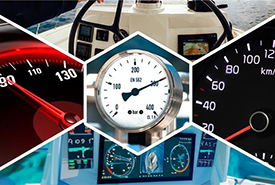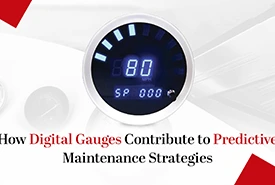- Free shipping for NZ Customers. All items are available in NZ warehouse
- +64 (0) 212576146
- [email protected]
How to Maintain Digital Gauges for Long Term Performance in Marine Settings?

Make the Switch to Electronic Gauges for Better Performance Tracking
October 11, 2024
When to Opt for Mechanical Gauges and When to Choose Electrical Gauges
October 25, 2024Ever had your digital gauge fail just when you needed it most? Or perhaps you’ve noticed readings becoming less reliable over time?
In the harsh marine environment, even the most advanced digital gauges can suffer wear and tear. But with the right maintenance, you can keep your gauges functioning like new for years. We’ll cover everything from regular cleaning routines to recalibration tips, all designed to help you maintain accuracy and extend the lifespan of your digital gauges.
Let’s ensure your gauges are always ready when you need them, whether you’re navigating coastal waters or heading out on the open sea.
Why Maintenance Is Key for Digital Gauges in Marine Settings?
Marine settings are tough on equipment. Saltwater, high humidity, temperature fluctuations, and constant vibrations can take a toll on digital gauges. Proper maintenance helps prevent issues like corrosion, inaccurate readings, and even complete gauge failure.
The Impact of Saltwater and Humidity
Saltwater is particularly corrosive, and when combined with high humidity, it can affect the internal components of digital gauges. Corrosion can lead to inaccurate readings or, in worst-case scenarios, cause the gauge to stop working altogether. Regular maintenance helps protect your investment and ensures that your gauges remain reliable.
The Importance of Accurate Readings
In a marine environment, accurate readings can mean the difference between a smooth trip and a potential hazard. For example, knowing the exact fuel level can help prevent running out of fuel when you’re far from shore. Regularly maintaining your digital gauges ensures that you’re getting the accurate data you need to make informed decisions on the water.
Cleaning Your Digital Gauges: Keep It Simple, Keep It Safe
One of the simplest yet most effective ways to maintain digital gauges is through regular cleaning. Clean gauges are easier to read, and keeping dirt and moisture at bay can help prolong their lifespan.
Wipe Down the Display Regularly
Use a soft, lint-free cloth to gently wipe down the display of your digital gauges. Avoid using abrasive materials that could scratch the screen. If there’s a buildup of salt or grime, lightly dampen the cloth with fresh water—never use saltwater—and gently clean the surface.
Avoid Harsh Chemicals
Using harsh chemicals can damage the display and the sensors inside the gauge. Stick to fresh water or a cleaner recommended by the gauge’s manufacturer. After cleaning, always dry the gauge thoroughly to prevent moisture from seeping into the electronics.
Check for Salt Residue
In a marine environment, salt residue can accumulate on the gauge’s surface and connections. Check for salt buildup and clean it off promptly. Salt can corrode connections and impact the accuracy of your readings. A regular rinse with fresh water helps prevent salt buildup.
Protecting Gauges from the Elements: A Shield Against Corrosion
Protection is key when it comes to maintaining digital gauges in marine settings. By shielding your gauges from harsh conditions, you can greatly extend their lifespan.
Use Protective Covers
Protective covers are a simple yet effective way to shield your digital gauges from direct exposure to saltwater and sunlight. Use these covers when your boat is not in use to keep the gauges safe from environmental damage.
Ensure Proper Sealing
Check that the seals around your digital gauges are intact and waterproof. Damaged or worn seals can allow moisture to enter, potentially causing malfunctions. If you notice any signs of wear, replace the seals immediately to maintain the waterproof integrity of your gauges.
Install Gauges in Protected Areas
Whenever possible, install your digital gauges in locations that are less exposed to splashes, direct sunlight, and vibrations. This positioning can reduce the impact of harsh conditions and help your gauges perform better over time.
Recalibrating Your Digital Gauges: Keep Accuracy in Check
Regular recalibration is crucial for keeping your digital gauges accurate. Over time, factors like temperature changes and vibrations can cause slight shifts in the accuracy of your readings. Recalibrating helps correct these shifts.
Follow the Manufacturer’s Guidelines
Most digital gauges come with specific calibration instructions from the manufacturer. Follow these guidelines closely to ensure your gauge provides the most accurate readings possible. This might include adjusting settings through a digital interface or using calibration tools that come with the gauge.
Set a Regular Calibration Schedule
It’s easy to forget about calibration until you notice inconsistent readings. Set a regular calibration schedule—every six months is a good starting point for most marine applications. More frequent calibration may be needed if you operate in rough conditions or if you rely heavily on precise data.
Test Accuracy After Recalibration
After recalibrating, test your digital gauge to make sure it’s providing accurate readings. Compare it against a known standard or reference tool to verify that the calibration was successful. If the readings still seem off, consider consulting a professional for further adjustments.
Inspecting and Maintaining Connections: A Hidden Key to Reliability
The connections between your digital gauges and the rest of your system are often overlooked but are just as important as the gauges themselves. Loose or corroded connections can lead to inaccurate data or intermittent failures.
Check Connections for Corrosion
Saltwater and moisture can corrode electrical connections over time. Inspect the wiring and terminals of your digital gauges regularly. If you notice any corrosion, clean the terminals with a contact cleaner designed for marine use. For severe corrosion, you may need to replace the affected connectors.
Tighten Loose Wires
Vibrations from the boat’s movement can cause connections to loosen over time. Make sure all wiring is securely fastened and that there are no loose wires. A secure connection ensures that the data from your digital gauge is transmitted accurately.
Use Waterproof Connectors
For added protection, use waterproof connectors when installing or maintaining your digital gauges. These connectors are designed to keep moisture out, reducing the risk of corrosion and helping maintain a stable connection.
Our Verdict
Maintaining digital gauges in marine settings doesn’t have to be a complicated process, but it does require regular attention. By keeping your gauges clean, protecting them from harsh conditions, recalibrating regularly, and ensuring secure connections, you can keep your gauges performing at their best for years to come.
These small maintenance habits can make a big difference, ensuring that your gauges continue to provide accurate, reliable data whenever you need it.
When you take care of your digital gauges, they take care of you—providing the critical information that keeps your marine adventures safe and smooth.
So, give your gauges a little love, and enjoy the peace of mind that comes with knowing your equipment is always ready to perform.
FAQs





